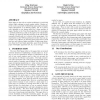Free Online Productivity Tools
i2Speak
i2Symbol
i2OCR
iTex2Img
iWeb2Print
iWeb2Shot
i2Type
iPdf2Split
iPdf2Merge
i2Bopomofo
i2Arabic
i2Style
i2Image
i2PDF
iLatex2Rtf
Sci2ools
111
click to vote
AIRWEB
2006
Springer
2006
Springer
Web Spam Detection with Anti-Trust Rank
Spam pages on the web use various techniques to artificially achieve high rankings in search engine results. Human experts can do a good job of identifying spam pages and pages whose information is of dubious quality, but it is practically infeasible to use human effort for a large number of pages. Similar to the Trust Rank algorithm [1], we propose a method of selecting a seed set of pages to be evaluated by a human. We then use the link structure of the web and the manually labeled seed set, to detect other spam pages. Our experiments on the WebGraph dataset [3] show that our approach is very effective at detecting spam pages from a small seed set and achieves higher precision of spam page detection than the Trust Rank algorithm, apart from detecting pages with higher pageranks [10, 11], on an average.
Related Content
| Added | 20 Aug 2010 |
| Updated | 20 Aug 2010 |
| Type | Conference |
| Year | 2006 |
| Where | AIRWEB |
| Authors | Vijay Krishnan, Rashmi Raj |
Comments (0)

